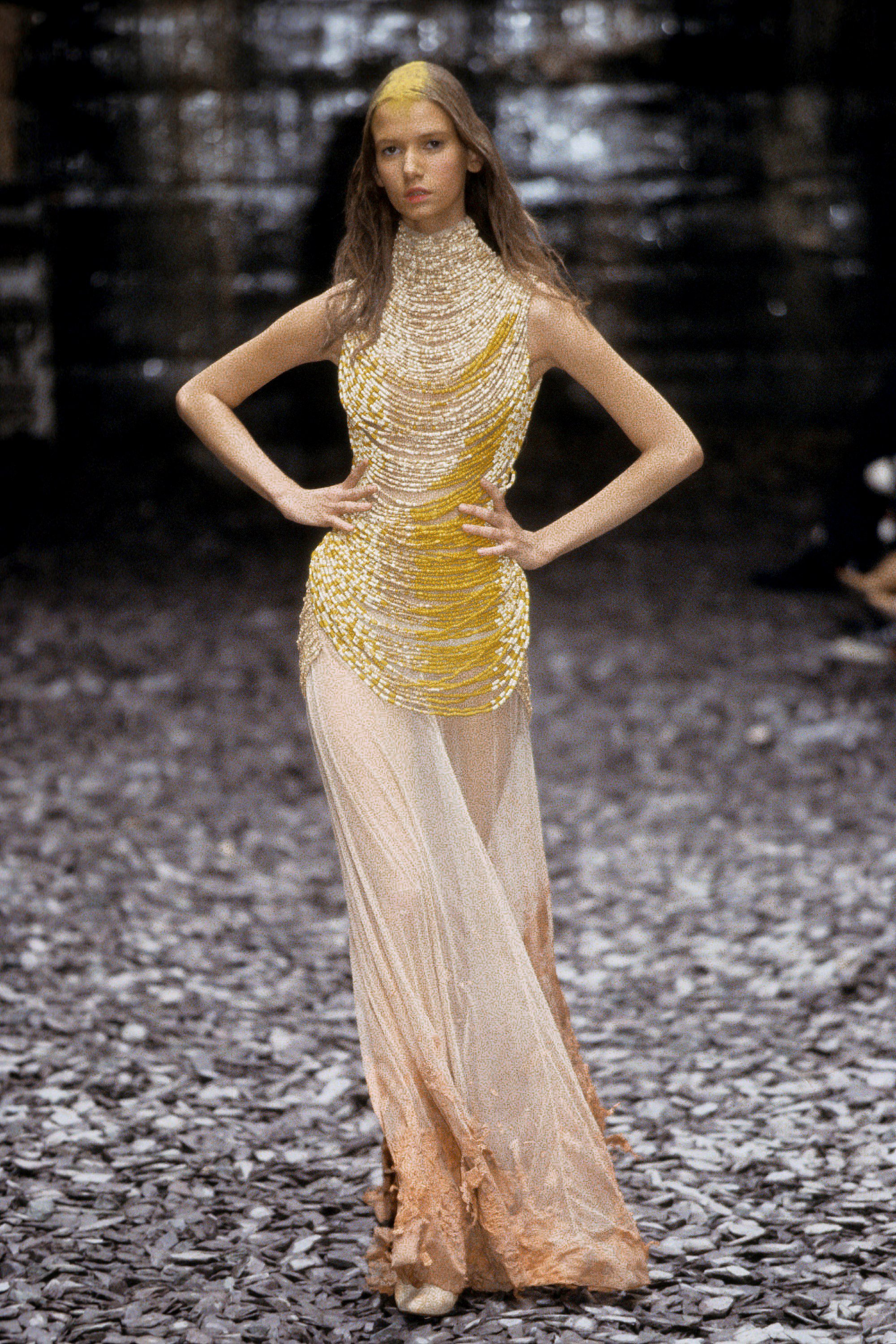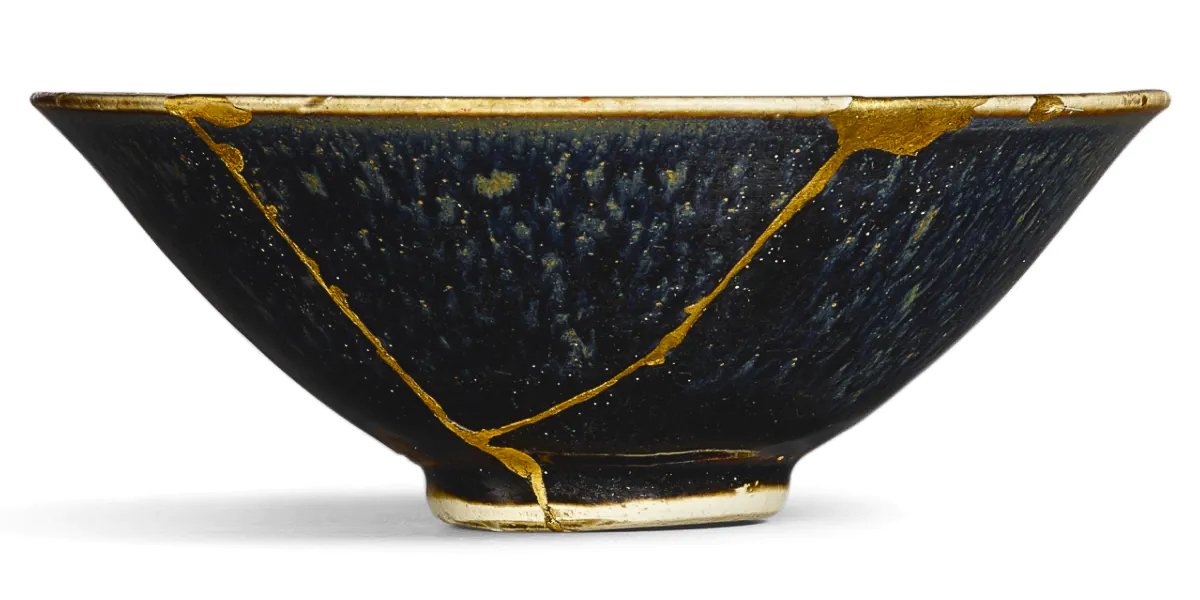GOLDEN SEAMS
Yellow Glass Bead and Horsehair Dress • Autumn / Winter 2000 Eshu Collection • Alexander McQueen • Image courtesy of Sølve Sundsbø via Alexander McQueen : Savage Beauty by Andrew Bolton in association with the 2011 exhibition at The Metropolitan Museum of Art, New York City
Though Alexander McQueen’s Fall 2000 Collection entitled Eshu was inspired by the Yoruba people of West Africa, his runway models seemed to appear as living examples of the centuries old Japanese art of Kintsugi… This traditional Japanese practice uses a precious metal – liquid gold, liquid silver or lacquer dusted with powdered gold – to bring together the pieces of a broken pottery item and at the same time enhance the breaks… Not only did the models have gold powder dusted along their hair parts and liquid silver dancing down their garments, the tour de force of the couture according to The Costume Institute’s Head Curator Andrew Bolton, was a dress embroidered with yellow glass beads interwoven with brown horsehair, quite reminiscent of an ashirai kebo, a specific brush made from horsehair that is used to apply the very fine gold or silver powder in the art of Kintsugi. Though this Japanese art form may not have been the cited inspiration for this particular collection, one was able to see quite clearly throughout The Met’s legendary Savage Beauty exhibition, that McQueen was never one to shy away from celebrating the beauty in imperfection…
Detail of an antique ashirai kebo, a specific brush made from horsehair that is used to apply the very fine gold or silver powder in the art of Kintsugi
Kintsugi (金継ぎ, “golden joinery”), also known as kintsukuroi (金繕い, “golden repair”) is the Japanese art of repairing broken pottery by mending the areas of breakage with lacquer dusted or mixed with powdered gold, silver, or platinum, a method similar to the maki-e technique. It has been dated as far back as the 15th century when Japanese shōgun Ashikaga Yoshimasa sent a damaged Chinese tea bowl back to China for repairs and was disappointed with the results, leading him to inspire Japanese artisans to develop a more aesthetically pleasing means of repair… As a philosophy, Kintsugi is similar to the Japanese philosophy of wabi-sabi, an embracing of the flawed or imperfect. Japanese aesthetics values marks of wear from the use of an object. This can be seen as a rationale for keeping an object around even after it has broken and as a justification of Kintsugi itself, highlighting the cracks and repairs as simply an event in the life of an object rather than allowing its service to end at the time of its damage or breakage.
Detail of the Yellow Glass Bead and Horsehair Dress • Autumn / Winter 2000 Eshu Collection • Alexander McQueen
Alek Wek captured on the runway wearing the famous Yellow Glass Bead and Horsehair Dress • Autumn / Winter 2000 Eshu Collection • Alexander McQueen
Japanese gold powder manufactured specifically for the art of Kintsugi • Image courtesy of Christian K. Bonner
Reconstructed tea bowl featuring the golden repairs of Kintsugi
Alek Wek modeling the famous Yellow Glass Bead and Horsehair Dress • Autumn / Winter 2000 Eshu Collection • Alexander McQueen • Image courtesy of Vogue Runway along with all additional runway images
Detail of a repair utilizing the centuries old Japanese art of Kintsugi
Reconstructed tea bowl featuring the golden repairs of Kintsugi • Edo Period
Contemporary glazed bowl featuring the golden repairs of Kintsugi • Naoko Fukumaru • Vancouver Art Gallery, Vancouver
LACMA conservators captured practicing the art of Kintsugi • 2021 • Image courtesy of LACMA Unframed • Los Angeles County Museum of Art, Los Angeles
Reconstructed tea bowl featuring the golden repairs of Kintsugi
Reconstructed tea bowl belonging to an Okakura tea set, featuring the golden repairs of Kintsugi • Style of Ogata Kenzan • 19th Century • Isabella Stewart Gardner Museum, Boston
Detail of a repair utilizing the centuries old Japanese art of Kintsugi • Image courtesy of Howard Freeman
Nude mud-covered gown adorned with ivory and yellow wooden beads • Autumn / Winter 2000 Eshu Collection • Alexander McQueen • Image courtesy of Sølve Sundsbø via Alexander McQueen : Savage Beauty by Andrew Bolton in association with the 2011 exhibition at The Metropolitan Museum of Art, New York City
Reconstructed Mishima ware bowl featuring Kintsugi repairs made with pure silver • Early Richo Period or Joseon Dynasty • Korea • Image courtesy of Kintugi
Reconstructed Mishima ware ceramic hakeme-type tea bowl featuring the golden repairs of Kintsugi • Joseon Dynasty • 16th Century • Korea • Ethnological Museum, Berlin
Reconstructed Rakuzan ware tea bowl in Kugibori Irabo style featuring the golden repairs of Kintsugi • Edo Period • Early 18th Century • Japan • Freer Gallery of Art in the Smithsonian's National Museum of Asian Art • Image courtesy of the Smithsonian Institution, Washington, D.C.
Detail of a restored vessel featuring featuring the golden repairs of Kintsugi
Dosai or Doraku black Raku glaze tea bowl featuring the golden repairs of Kintsugi • Edo Period • 19th Century • Japan • Freer Gallery of Art in the Smithsonian's National Museum of Asian Art • Image courtesy of the Smithsonian Institution, Washington, D.C.
Alexander McQueen captured amusing his design team and muse, Isabella Blow, who is modeling his Yellow Glass Bead and Horsehair Dress • Autumn / Winter 2000 Eshu Collection • Alexander McQueen • September 1, 2000 • North London Studio • Vogue • Annie Leibovitz
Underside view of a restored Tsuki dish made of high-fired stoneware featuring the golden repairs of Kintsugi • Kofun Period • Circa 250 - 600 • Japan • The British Museum, London
Reconstructed tea bowl featuring the golden repairs of Kintsugi • Image courtesy of Maikoya Kimono Tea Ceremony, Kyoto
Reconstructed tea bowl featuring the golden repairs of Kintsugi • Image courtesy of Esprit Kintsugi
A dinner plate restored by chef Maxime Gilbert for his restaurant Écriture, utilizing the ancient Japanese art of Kintsugi • Image courtesy of Michelin Guide
Nika and Stella modeling ensembles from McQueen’s 2000 Eshu collection courtesy of the Alexander McQueen Archive • 2015 • AnOther Magazine • Nick Knight
Rare Yaozhou black glazed bowl featuring the golden repairs of Kintsugi • Northern Song Dynasty • Circa 960 - 1127 A.D. • China • Image courtesy of Sotheby's
The art of Kintsugi restoration captured during the application of gold powder • Image courtesy of Kintsugi Club
Reconstructed dish featuring the golden repairs of Kintsugi • Image courtesy of Matcha Tea
Antique Japanese soba cup restored utilizing the ancient Japanese art of Kintsugi • Image courtesy of RealKintsugi
Early Karatsu ware ceramic bowl featuring the golden repairs of Kintsugi • Circa 1600 • Japan • Image courtesy of 1st Dibs
Anouck Lepère modeling a dress from McQueen’s 2000 Eshu collection • October 2000 • Harper’s Bazaar • Craig McDean
The art of Kintsugi restoration captured during the preparation of silver powder • Image courtesy of Garland Magazine
Reconstructed tea bowl featuring the silver powder and lacquer repairs of Kintsugi • Image courtesy of Yun Journal
Björk modeling a dress from McQueen’s 2000 Eshu collection • September 1, 2000 • Vogue • Steven Klein


















































